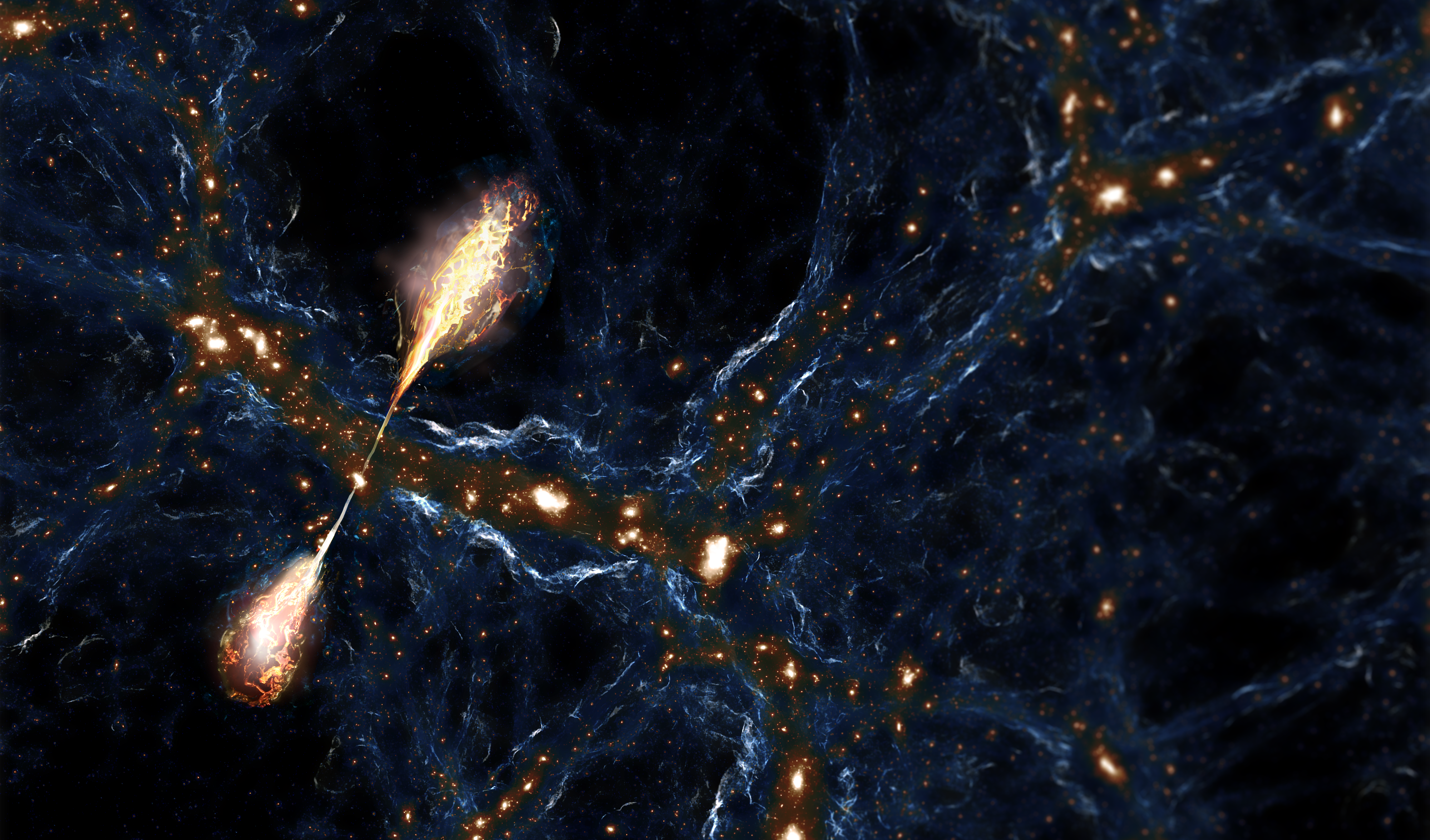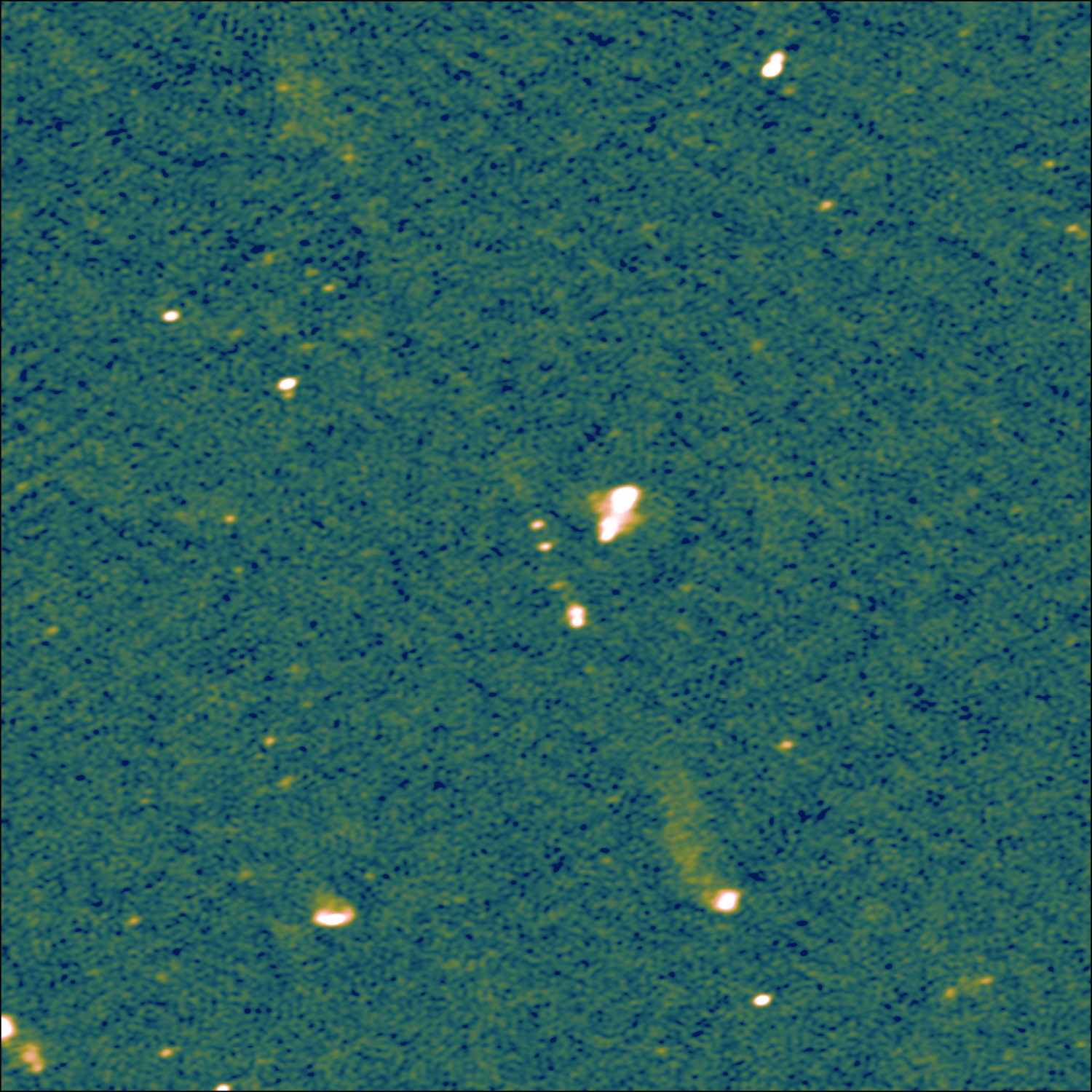The jets shooting out from an enormous black hole are larger than was thought theoretically possible, and may change ideas about how galaxies developed. This pair are the longest, and therefore most powerful, jets we have yet found, with a combined length of 23 million light-years, more than 10 times the distance between the Milky Way and the Andromeda Galaxy.
The supermassive black hole (SMBH) responsible for these epic jets is no doubt immense, but more surprisingly, we are seeing it as it was 7.5 billion years ago, that is when the universe was a little under half its current age. Anything this epic needs a nickname and the astronomers who found it have called it Porphyrion, after a giant in Greek myth, following the pattern of calling the previous record jets Alcyoneus. Porphyrion is 40 percent larger than its fellow giant, which was previously thought to represent a theoretical maximum.
“This pair is not just the size of a solar system, or a Milky Way; we are talking about 140 Milky Way diameters in total,” said Caltech’s Dr Martijn Oei in a statement. “The Milky Way would be a little dot in these two giant eruptions.”
Galaxies form on what is known as the cosmic web, strands of material that is more concentrated than the rest of the universe. When the universe was smaller, the web’s strands were shorter and denser than today. These jets could almost cross one of the cosmic voids within the web at the time.

Artist’s impression of Porphyrion or a similar jet shooting into a void in the cosmic web.
Image credit: E. Wernquist / D. Nelson (IllustrisTNG Collaboration) / M. Oei
“Astronomers believe that galaxies and their central black holes co-evolve, and one key aspect of this is that jets can spread huge amounts of energy that affect the growth of their host galaxies and other galaxies near them,” said Caltech’s Professor George Djorgovski. “This discovery shows that their effects can extend much farther out than we thought.”
Although the team that made the discovery are confident jets like these would influence galaxies they encounter, they don’t know exactly how. Oei wants to explore the extent to which they magnetize the web, for example.
A single pair of jets may influence dozens of galaxies around them, but that’s still tiny among the billions of galaxies. However, while Porphyrion is staggering in its size, it was found in the course of a survey that has revealed powerful jets are much more common than had been suspected. Conducted using the Low Frequency Array radio telescope (LOFAR), the project has found 11,000 of these giant jets already and is far from done. The number, as much as the size of the largest example, has surprised those conducting the search.
“Giant jets were known before we started the campaign, but we had no idea that there would turn out to be so many,” said Professor Martin Hardcastle of the University of Hertfordshire.
When material starts to spiral into a black hole the energy generated has to go somewhere and is released through a mix of radiation and jets accelerating particles to close to the speed of light.
We have seen blazing accretion disks from giant black holes from the era when we’re now seeing Porphyrion, and much further back, but giant jets are a different matter. “Up until now, these giant jet systems appeared to be a phenomenon of the recent universe,” Oei said. “If distant jets like these can reach the scale of the cosmic web, then every place in the universe may have been affected by black hole activity at some point in cosmic time.”

Somehow the actual images taken of Porphyrion are a lot less dramatic than the artist’s impression, unless you can visualize the scale.
Image credit: LOFAR Collaboration/WISE/NASA/JPL-Caltech/Martijn Oei (Caltech)
However, the LOFAR survey has shown this story of evolution from radiative to jet mode as the universe aged needs a rethink.
While most of the thousands of newly discovered jets are just lines in a database, something as epic as Porphyrion required much closer attention. Two radio telescopes with different capacities from LOFAR were used to identify which of two possible galaxies Porphyrion came from. Unsurprisingly, the galaxy is also a giant, with an estimated mass 10 times that of the Milky Way. Considering how our own galaxy has grown in the interim by consuming smaller star collections, the differences between the two at comparable age are even greater.
More strikingly, however, this work showed that Porphyrion’s black hole is also radiating strongly, making its total energy release even more epic than the initial observations revealed.
Porphyrion’s demonstration that strongly radiating black holes can also produce mighty jets raises the obvious question of how common this is.
“We may be looking at the tip of the iceberg,” Oei said. “Our LOFAR survey only covered 15 percent of the sky. And most of these giant jets are likely difficult to spot, so we believe there are many more of these behemoths out there.”
Fortunately, we now have plenty of other distant jets to explore to see how many are radiating strongly as well. A forthcoming paper announces 8,000 of them. Although machine learning helps identify candidates for these jets in radio images, this is an area where the human eye, even that of amateurs, has still not been matched, so citizen scientists provided a crucial stage in identifying the objects.
To produce jets like Porphyrion’s you don’t just need a very large and voraciously feeding SMBH. It must also be stable, so the jets keep pointing in the same direction and don’t have forces around them to distort the flows. Hardcastle thinks such stability must have lasted a billion years, although how it was maintained is another thing the team wish to explore.
If your mind is not sufficiently blown by Porphyrion’s size, be aware the 23 million light-years is a minimum – depending on how it is inclined relative to us, it could be substantially longer.
The study describing Porphyrion is published in Nature. The study on the 8,000 new jet systems will be published in Astronomy & Astrophysics (preprint on arXiv.org).
Source Link: Truly Supermassive Black Hole Has Jets Spanning 23 Million Light-Years, The Biggest Ever Seen